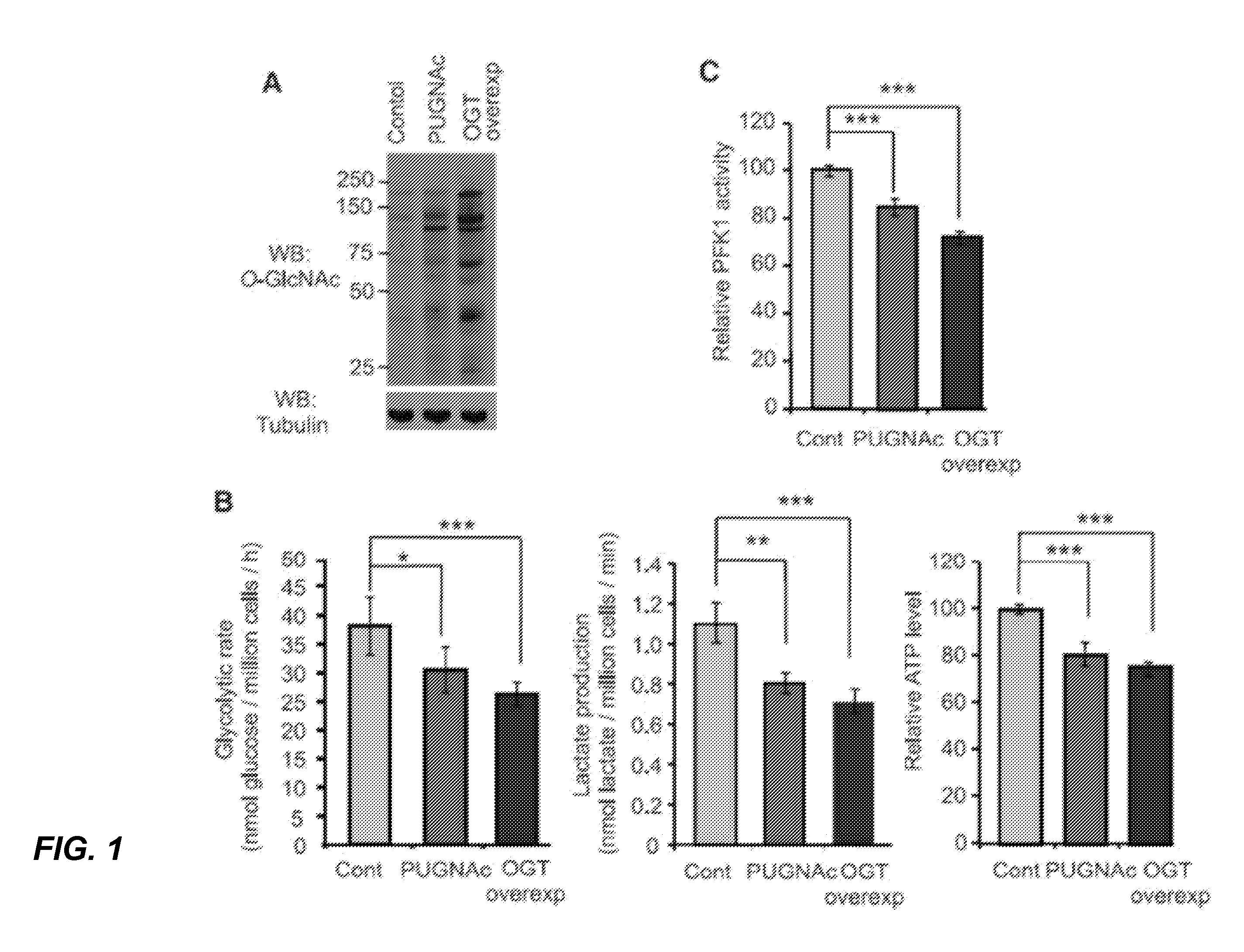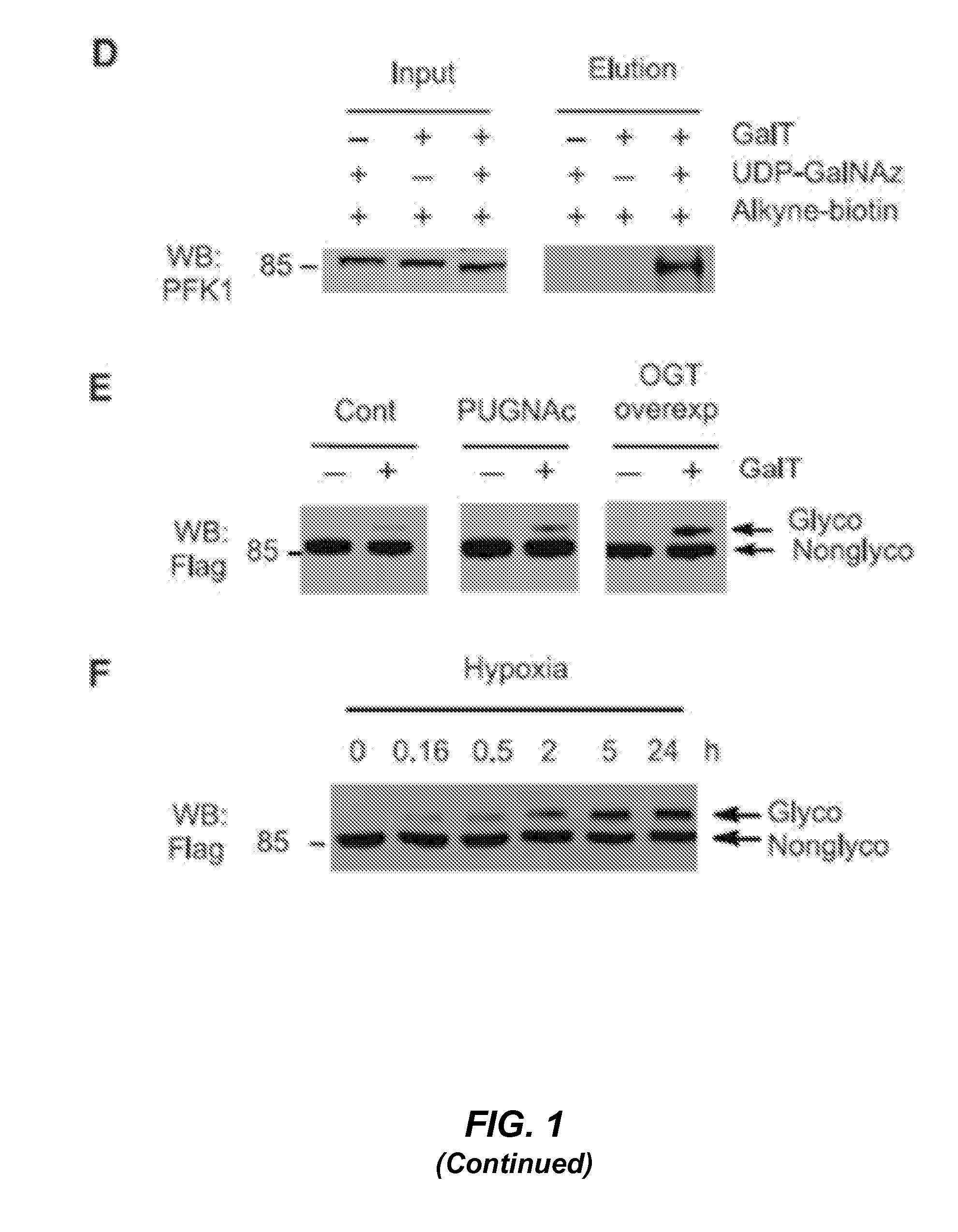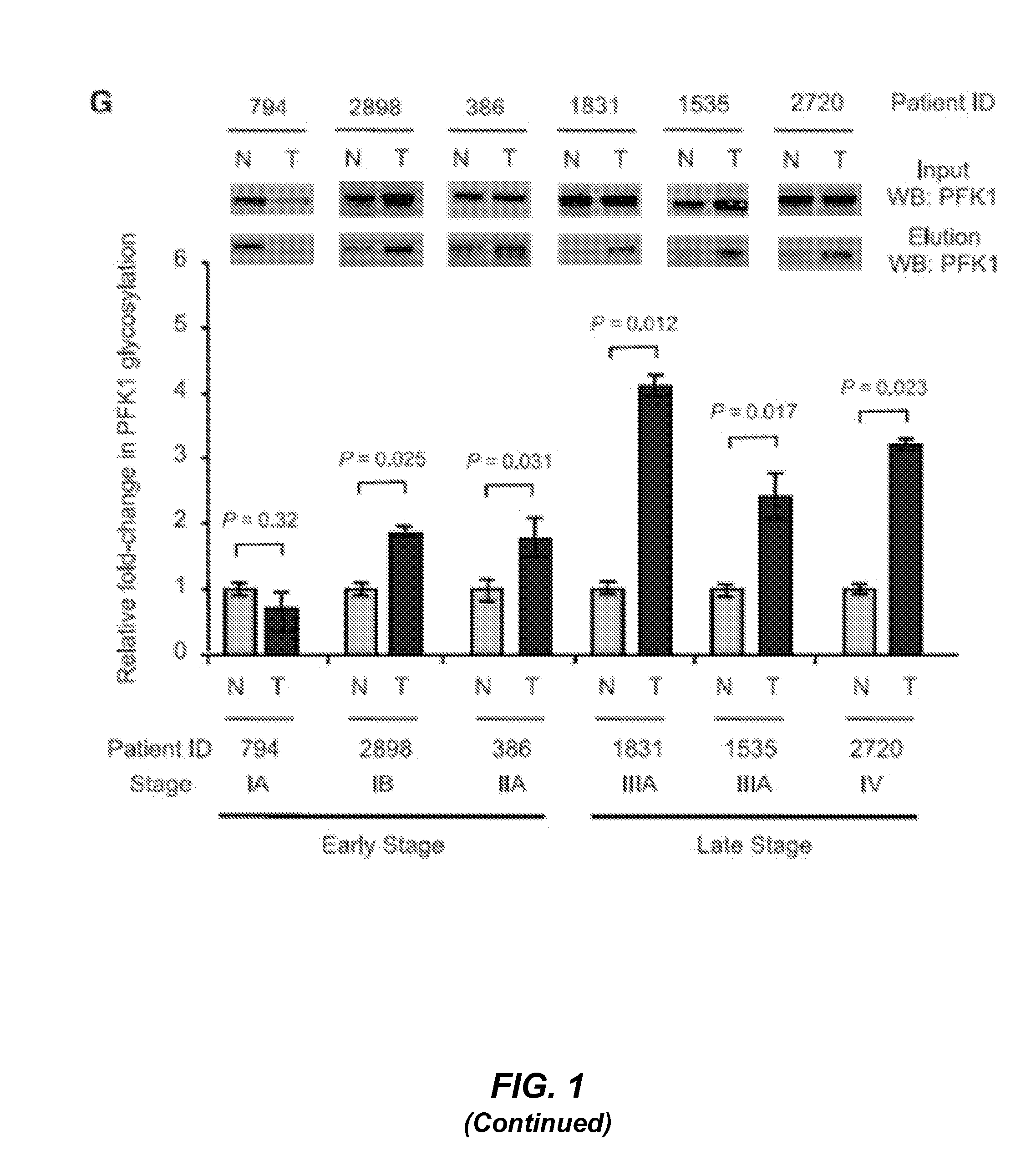Targeting phosphofructokinase and its glycosylation form for cancer
a phosphofructokinase and glycosylation technology, applied in the field of cancer-specific phosphofructokinase and its glycosylation form, can solve the problems that the effective treatment of cancer remains a major challenge for modern medicine, and achieve the effects of increasing pfk-1 activity, reducing pfk-1 glycosylation, and increasing pfk-1 activity
- Summary
- Abstract
- Description
- Claims
- Application Information
AI Technical Summary
Benefits of technology
Problems solved by technology
Method used
Image
Examples
example 1
Cell Culture and Tumor Tissues
[0166]The cell lines 293T, A549, H1299, LNCaP, MCF-10A, MCF-7, MDA-mb-231, PrEc, DU145, HepG2, HCT15, HeLa and human dermal fibroblasts were obtained from ATCC and cultured according to ATCC protocols. MCF-10AT cells were obtained from the Barbara Ann Karmanos Cancer Institute (Detroit, Mich.). MCF10-DCIS.com cells were purchased from Asterand, Inc. Both MCF-10AT and MCF10-DCIS.com cells were cultured in Dulbecco's modified Eagle media (DMEM) / F12 (1:1) medium (Invitrogen) with 5% horse serum (Invitrogen), 0.029 M sodium bicarbonate, 10 mM HEPES, 10 μg ml−1 insulin (Sigma-Aldrich), and 0.5 μg ml−1 hydrocortisone (Sigma-Aldrich)
[0167]Breast tumor tissues and matching tumor-adjacent normal tissues from the same patient were obtained from Agios Pharmaceuticals (Cambridge, Mass.). Lung tumor tissues and matching tumor-adjacent normal tissues from the same patient were obtained from the Tumor and Tissue Bank, University of Massachusetts Medical School.
example 2
Immunoblotting
[0168]SDS lysis buffer (1% SDS, 50 mM Tris-HCl, pH 7.5, 100 mM NaCl, 10 μM PUGNAc, and Complete™ protease inhibitors (Roche)) was used to lyse the cells, and the lysate was resolved by 4-12% SDS-PAGE, transferred to Immobilon-FL PVDF membrane (Millipore), and immunoblotted with the indicated antibodies. Antibodies used in this study were obtained from the following sources: O-GlcNAc antibody (RL-2, Affinity BioReagents, 1:1000 working dilution), PFK1 antibody (Santa Cruz Biotechnology, 1:1000 working dilution), Flag antibody (Sigma-Aldrich, 1:5000 working dilution), Myc antibody (Sigma-Aldrich, 1:5000 working dilution), OGT antibody (DM-17, Sigma-Aldrich, 1:1000 working dilution), OGA antibody (Sigma-Aldrich, 1:1000 working dilution), and tubulin antibody (Sigma-Aldrich, 1:5000 working dilution). The BCA protein assay (Pierce) was used to measure all protein concentrations. Western blots were visualized and quantified using an Odyssey Infrared Imaging System (LI-COR Bi...
example 3
Modulation of Cellular O-GlcNAc Levels
[0169]Cellular O-GlcNAc levels were modulated by OGT overexpression or PUGNAc treatments. For OGT overexpression experiments, H1299, A549, or 293T cells were transiently transfected with a pDEST26 / HA-OGT vector (provided by L. Wells) using Lipofectamine 2000 reagent (Invitrogen) according to the manufacturer's protocol. Cells were collected 36 h after transfection, lysed in SDS lysis buffer containing 5 μM O-(2-acetamido-2-deoxy-D-glucopyranosylidene) amino Nphenylcarbamate (PUGNAc; Toronto Research Chemicals), and immunoblotted for OGlcNAc levels. For PUGNAc treatments to enhance O-GlcNAc levels, cells cultured in DMEM high glucose media (with 10% FBS, penicillin / streptomycin (100 U ml−1); Invitrogen) or RPMI 1640 media (with 10% FBS, penicillin / streptomycin (100 U ml−1); Invitrogen) were treated with PUGNAc (100 μM) for 9 h and then immunoblotted for OGlcNAc levels. OGT overexpression and PUGNAc treatment did not affect cell viability, as dete...
PUM
| Property | Measurement | Unit |
|---|---|---|
| pH | aaaaa | aaaaa |
| pH | aaaaa | aaaaa |
| pH | aaaaa | aaaaa |
Abstract
Description
Claims
Application Information
 Login to View More
Login to View More - R&D
- Intellectual Property
- Life Sciences
- Materials
- Tech Scout
- Unparalleled Data Quality
- Higher Quality Content
- 60% Fewer Hallucinations
Browse by: Latest US Patents, China's latest patents, Technical Efficacy Thesaurus, Application Domain, Technology Topic, Popular Technical Reports.
© 2025 PatSnap. All rights reserved.Legal|Privacy policy|Modern Slavery Act Transparency Statement|Sitemap|About US| Contact US: help@patsnap.com



